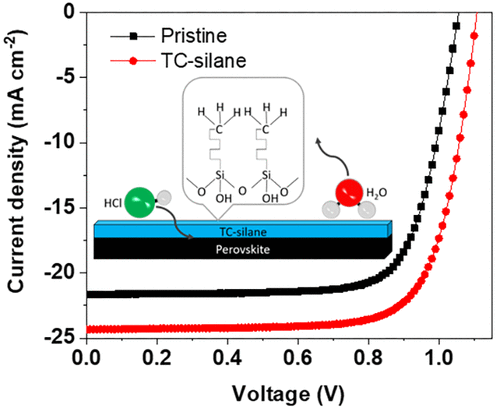当前位置:
X-MOL 学术
›
ACS Appl. Energy Mater.
›
论文详情
Our official English website, www.x-mol.net, welcomes your
feedback! (Note: you will need to create a separate account there.)
Bifunctional Effects of Trichloro(octyl)silane Modification on the Performance and Stability of a Perovskite Solar Cell via Microscopic Characterization Techniques
ACS Applied Energy Materials ( IF 5.4 ) Pub Date : 2020-03-16 00:00:00 , DOI: 10.1021/acsaem.9b02306 Shenghe Zhao 1 , Minchao Qin 2 , Yuren Xiang 3 , Han Wang 1 , Jiangsheng Xie 1 , Li Gong 4 , Jian Chen 4 , Xinhui Lu 2 , Jun Song 3 , Junle Qu 3 , Jianbin Xu 1 , Keyou Yan 1, 5
ACS Applied Energy Materials ( IF 5.4 ) Pub Date : 2020-03-16 00:00:00 , DOI: 10.1021/acsaem.9b02306 Shenghe Zhao 1 , Minchao Qin 2 , Yuren Xiang 3 , Han Wang 1 , Jiangsheng Xie 1 , Li Gong 4 , Jian Chen 4 , Xinhui Lu 2 , Jun Song 3 , Junle Qu 3 , Jianbin Xu 1 , Keyou Yan 1, 5
Affiliation

|
Passivation by small organic compounds can reduce the trap density and enhance the humidity and illumination stability of perovskite solar cells (PSCs). However, the small molecule passivated on the perovskite film cannot endure harsh heat stress. Herein, we find that the trichloro(octyl)silane (TC-silane) is an excellent candidate to modify the perovskite surface and grain boundary nondestructively through the formation of a heat-resistive silicone layer, leading to a comprehensive improvement of efficiency and stability with low cost as well as facile fabrication. The silane is a type of solvent and can be upscaled by a solution process in the device. TC-silicone can cross-link the grain boundaries through hydrolytic condensation. The cross-linking silicone can resist the moisture and heat stresses to enhance the stability. Also, microphotoluminescence reveals that TC-silane treatment can passivate the perovskite film and enhance the optoelectronic properties through chloride replenishment by releasing a hydrogen chloride molecule in the hydrolytic reaction. By utilizing Kevin probe force microscopy, we further uncover that TC-silane forms a dipole layer to facilitate the charge separation. TC-silane passivated PSCs deliver a champion efficiency of 20.03% and remain at 80% of their initial efficiency for more than 800 h at 70–80% relative humidity in air and for about 80 h under 85 °C thermal stress without encapsulation.
中文翻译:

三氯(辛基)硅烷改性对钙钛矿型太阳能电池性能和稳定性的微观影响
小型有机化合物的钝化可降低陷阱密度,并增强钙钛矿太阳能电池(PSC)的湿度和照明稳定性。但是,钝化在钙钛矿膜上的小分子不能承受苛刻的热应力。在这里,我们发现三氯(辛基)硅烷(TC-硅烷)是通过形成耐热性有机硅层无损地改变钙钛矿表面和晶界的极佳候选者,从而全面提高了效率和稳定性。低成本以及易于制造。硅烷是一种溶剂,可以通过设备中的溶液工艺进行规模放大。TC-硅氧烷可以通过水解缩合使晶界交联。交联有机硅可以抵抗潮气和热应力,从而提高稳定性。也,微光致发光表明,TC-硅烷处理可钝化钙钛矿薄膜,并通过在水解反应中释放氯化氢分子来补充氯化物,从而增强钙钛矿的光电性能。通过使用凯文探针力显微镜,我们进一步发现TC-硅烷形成偶极子层,以促进电荷分离。TC-硅烷钝化的PSC的最佳效率为20.03%,在空气中相对湿度为70-80%的情况下,在800h以上的时间内保持其初始效率的80%,并且在85°C的热应力下保持80%的初始效率而没有封装。通过使用凯文探针力显微镜,我们进一步发现TC-硅烷形成偶极子层,以促进电荷分离。TC-硅烷钝化的PSC的最佳效率为20.03%,在空气中相对湿度为70-80%的情况下,在800h以上的时间内保持其初始效率的80%,并且在85°C的热应力下保持80%的初始效率而没有封装。通过使用凯文探针力显微镜,我们进一步发现TC-硅烷形成偶极子层,以促进电荷分离。TC-硅烷钝化的PSC的最佳效率为20.03%,在空气中相对湿度为70-80%的情况下,在800h以上的时间内保持其初始效率的80%,并且在85°C的热应力下保持80%的初始效率而没有封装。
更新日期:2020-03-16
中文翻译:

三氯(辛基)硅烷改性对钙钛矿型太阳能电池性能和稳定性的微观影响
小型有机化合物的钝化可降低陷阱密度,并增强钙钛矿太阳能电池(PSC)的湿度和照明稳定性。但是,钝化在钙钛矿膜上的小分子不能承受苛刻的热应力。在这里,我们发现三氯(辛基)硅烷(TC-硅烷)是通过形成耐热性有机硅层无损地改变钙钛矿表面和晶界的极佳候选者,从而全面提高了效率和稳定性。低成本以及易于制造。硅烷是一种溶剂,可以通过设备中的溶液工艺进行规模放大。TC-硅氧烷可以通过水解缩合使晶界交联。交联有机硅可以抵抗潮气和热应力,从而提高稳定性。也,微光致发光表明,TC-硅烷处理可钝化钙钛矿薄膜,并通过在水解反应中释放氯化氢分子来补充氯化物,从而增强钙钛矿的光电性能。通过使用凯文探针力显微镜,我们进一步发现TC-硅烷形成偶极子层,以促进电荷分离。TC-硅烷钝化的PSC的最佳效率为20.03%,在空气中相对湿度为70-80%的情况下,在800h以上的时间内保持其初始效率的80%,并且在85°C的热应力下保持80%的初始效率而没有封装。通过使用凯文探针力显微镜,我们进一步发现TC-硅烷形成偶极子层,以促进电荷分离。TC-硅烷钝化的PSC的最佳效率为20.03%,在空气中相对湿度为70-80%的情况下,在800h以上的时间内保持其初始效率的80%,并且在85°C的热应力下保持80%的初始效率而没有封装。通过使用凯文探针力显微镜,我们进一步发现TC-硅烷形成偶极子层,以促进电荷分离。TC-硅烷钝化的PSC的最佳效率为20.03%,在空气中相对湿度为70-80%的情况下,在800h以上的时间内保持其初始效率的80%,并且在85°C的热应力下保持80%的初始效率而没有封装。

































 京公网安备 11010802027423号
京公网安备 11010802027423号